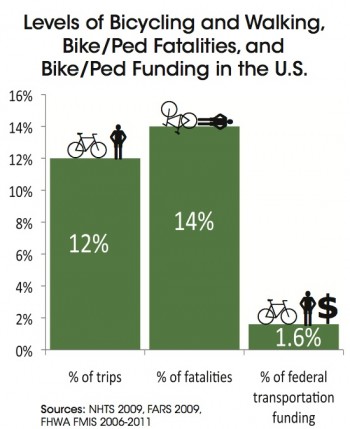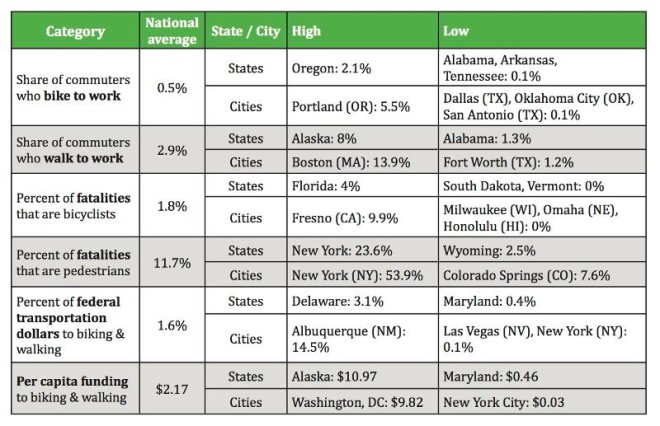
Is the US a Cycling Nation? US States and Cities Under the Microscope

Cycling in New York City, cited by a recent report as spending only $0.03 per capita on bike and walking infrastructure: Credit: noa.cortes (Flickr)
There’s no denying that America has a huge potential to be a cycling nation. In 2009, 40% of trips in the United States were shorter than 2 miles, yet 87% of these trips are by car. A new report from ECF’s associate member, the Alliance for Biking & Walking, ranks all 50 states and the 51 largest U.S. cities on bicycling and walking levels. Despite progress, there’s still a long way to go...
Insight: ECF Staff Member, Randy Rzewnicki
"I grew up in the USA, lived there for 30 years (before settling in Belgium 20 years ago.) Everything’s about cars there: drive in movies, breakfast & coffee, and of course, drive through banking.
People eat and drink and have office equipment in their cars. US cars have lots of cup holders for coffee, soda, etc. And since so few people are willing to risk life and limb walking or cycling on streets, what that goes with is little to no attention to infrastructure for walking or cycling.
This makes these activities for transport very dangerous. So you have a vicious circle. When I visit family in the US I find it very cheeky to see traffic signs that have a bike logo and the text: SHARE THE ROAD.
It’s shameless, it really is. So, it’s no surprise that overweight and obesity increase, and Europe’s not immune.”
America could really be a cycling continent. It’s a country with transport systems that are emulated the world over and to imagine the U.S. becoming a cycling nation would be every cycling advocate’s dream, even those living in Europe. Developing and developed countries often look to the US for guidance: in the past it’s been giant cars and trucks and sprawling interstates that have been reproduced from Beijing to Bucharest. Imagine if people began looking to the US for bicycle solutions?
This new report uses statistics from the U.S. Census, the American Community Survey (ACS), the National Highway and Transportation Safety Administration (NHTSA), and other sources. There is nothing new in the way of stats, but they’ve been presented in a highly informative way.
Now for some of the key figures in the report:
- In 2009, 40% of trips in the United States were shorter than 2 miles, yet 87% of these trips are by car. 27% of trips were shorter than 1 mile. Even then, Americans use their cars for 62% of these trips.
- While bicycling and walking fell 66% between 1960 and 2009, obesity levels increased 156%.
- Seniors are the most vulnerable bicyclists and pedestrians. Adults over 65 make up 10% of walking trips, yet comprise 19% of pedestrian fatalities. This age group accounts for 6% of bicycling trips, yet 10% of bicyclist fatalities.
- Bicycling and walking projects create 11-14 jobs per $1 million spent, compared to just 7 jobs created per $1 million spent on highway projects. Cost benefit analysis shows that up to $11.80 in benefits can be gained for every $1 invested in bicycling and walking.
- On average, the largest 51 U.S. cities show a 29% increase in bicycle facilities since the 2010 report. Cities report that 20,908 miles of bicycle facilities and 7,079 miles of pedestrian facilities are planned for the coming years (much of this is contingent upon funding).
Spend More Money to Save Lives.
In nearly every city and state, pedestrians and bicyclists are disproportionately at risk of being killed, and walking and cycling receive less than a fair share of transportation dollars. Only 1.6% of federal transportation funding goes to funding walking and cycling infrastructure. A similar problem is at hand in the EU: From 2007 until 2013, the Commission has earmarked €600 million for cycling infrastructure. That’s just 0.7% of an €82 billion fund. By contrast, road infrastructure receives some 47% of the EU’s transport infrastructure funds, which can be used to leverage national investment. Bicycle advocacy groups, such as ours, are calling for 10% of funding to be earmarked for cycling.
Increasing cyclists’ safety is not about putting helmets on heads. “Death by Design” can be a real killer for cyclists, and if funds are not earmarked for adequate infrastructure, then sadly, cyclist deaths will continue. (It should of course be remembered that cycling in itself is not a dangerous activity. In actually fact, you’ve got more chance being seriously injured as a motor vehicle occupant according to this Danish Study. According to the World Health Organisation, physical inactivity is also a killer.)
New York's Cycling Revolution Still Needs Money.
Scan the media for cycling, and popping up on the radar has been New York’s cycling revolution. Newspapers are full of stories about the Big Apple’s push for increased pedal power, with talk of a new bicycle share scheme and more on-road bicycle paths. It’s now time for Government to finance this long-awaited change. According to figures supplied by the study, New York City spends $0.03 per capita on biking and walking. Washington DC in comparison spends an approximate $9.82. The Dutch actually spend a whopping €30 ($39) a head. Unsurprisingly, New York City’s modal share sits below 1%, while the Netherlands has one third of all trips done by bicycle. The more money spent on cyclists, the more cyclists to hit the streets.
It’s not all bad news.
"The data points to one conclusion: Investing in biking and walking projects creates jobs, leads to more people biking and walking, and improves safety and public health," says Jeffrey Miller, who heads the Alliance behind the report.
Indeed, it proves that the potential for cycling is huge in the US and is on the rise. From 2000 to 2009, bicycling commuters in the U.S. rose by 57%. If 40% of trips were less than two miles, but 87% of them were taken by car, then surely there’s a brilliant scope for more people to get on bicycles.
Julian Ferguson is the Communications Officer for the European Cyclists’ Federation. Originally hailing from Australia and a keen bicycle advocate, he plans one day to ride his bicycle from Brussels to Melbourne
Why the interest in North America?
ECF is not just interested in cycling in Europe. We think it’s important to take a global perspective. So much so that our next big conference, Velo-city Global 2012, is taking place in Vancouver on the 26-29th of June. It’s the biggest cycling planning conference in the world, bringing together the best and the brightest in cycling and transport policy. Check out the conference website here, and register now for discount early bird tickets. It’s going to be a great event.
Contact the author
Recent news!
Upcoming events
Contact Us
Avenue des Arts, 7-8
Postal address: Rue de la Charité, 22
1210 Brussels, Belgium













